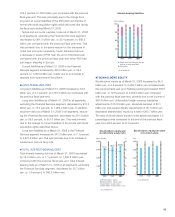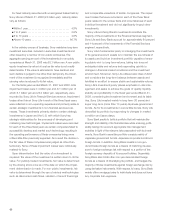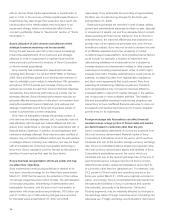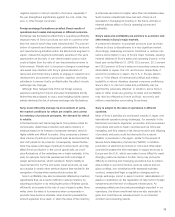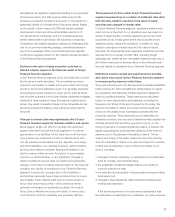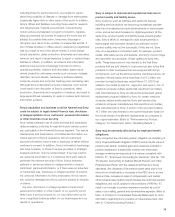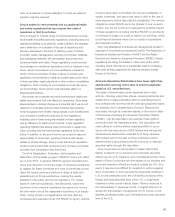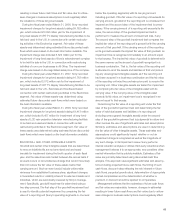Sony 2008 Annual Report Download - page 75
Download and view the complete annual report
Please find page 75 of the 2008 Sony annual report below. You can navigate through the pages in the report by either clicking on the pages listed below, or by using the keyword search tool below to find specific information within the annual report. 73
discussed elsewhere in this annual report, including without
limitation in the other sections of this annual report referred to
in the Cautionary Statement.
Sony must overcome increasingly intense pricing competition,
especially in the Electronics and Game segments.
Sony’s Electronics segment produces consumer products that
compete against products sold by an increasing number of
competitors on the basis of several factors including price. In
order to produce products that appeal to changing and increas-
ingly diverse consumer preferences, and to overcome the fact
that a relatively high percentage of consumers already possess
products similar to those that Sony offers, Sony’s Electronics
and Game segments must develop superior technology,
anticipate consumer tastes and rapidly develop attractive
products. In the Electronics segment, Sony faces increasingly
intense pricing pressure and shorter product cycles in a variety
of consumer product categories. Sony’s sales and operating
income depend on Sony’s ability to continue to develop effi-
ciently and offer Electronics and Game products at competitive
prices that meet changing and increasingly diverse consumer
preferences. If we are unable to effectively anticipate and
counter the price erosion that frequently accompanies our
products, or if the average selling prices of our products
decrease faster than we are able to reduce our manufacturing
costs, our gross margins will decrease and our results of
operations and financial condition may be negatively impacted.
To remain competitive and stimulate customer demand,
Sony must successfully manage frequent product and
service introductions and transitions.
Due to the highly volatile and competitive nature of the PC,
consumer electronics and mobile communication industries,
Sony must continually introduce new products, services and
technologies, enhance existing products and services, and
effectively stimulate customer demand for new and upgraded
products and services. The success of new product and service
introductions depends on a number of factors, including timely
and successful completion of development efforts, market
acceptance, Sony’s ability to manage the risks associated with
new products and production ramp-up issues, the availability of
application software for new products, the effective manage-
ment of purchase commitments and inventory levels in line with
anticipated product demand, the availability of products in
appropriate quantities and costs to meet anticipated demand,
and the risk that new products and services may have quality
or other defects in the early stages of introduction. Accordingly,
Sony cannot determine in advance the ultimate effect that new
product introductions and transitions will have on financial
condition and operating results.
Sony is subject to competition from firms that may be more
specialized or have greater resources.
Sony has several business segments in different industries and
has many product categories within the Electronics segment,
which causes it to face a broad range of competitors ranging
from large international companies to highly specialized entities
that are focused on only a few businesses. As a result, Sony
may not fund or invest in certain of its businesses to the same
degree that its competitors do, and these competitors may have
greater financial, technical, and marketing resources available to
them than the businesses of Sony. Sony’s financial services
businesses may not be able to compete effectively, especially
against established competitors with greater financial, marketing
and other resources.
Sony’s investments in research and development may not
yield the results expected.
Sony’s businesses, particularly the Electronics and Game
segments, operate in intensely competitive markets character-
ized by changing consumer preferences and rapid technological
innovation. Due to technological innovation and ease of imita-
tion, new products tend to become standardized rapidly, leading
to intense competition and price declines. In order to strengthen
the competitiveness of its products in this environment, Sony
is continuing to invest heavily in research and development.
However, these investments in research and development
may not yield the results expected, hindering Sony’s ability to
commercialize in a timely manner new and competitive products
that meet the needs of the market, which consequently, may
negatively impact Sony’s results.
Sony may not be able to recoup the large capital
expenditures or investments it makes to increase
production capacity.
Sony continues to invest heavily in production equipment in
the Electronics segment. Sony also invests in production-
related joint ventures. One recent example is the investment
Sony and Samsung made in connection with 8th generation
production capacity for amorphous TFT LCD panel produc-
tion, following investments in 7th generation production
capacity, at S-LCD, a joint venture of the two companies.
The accumulated total amount of the investment in S-LCD by
Sony and Samsung for 7th and 8th generation production
capacity is approximately 400 billion yen (approximately 50
percent of which was contributed by Sony). Sony may not be


